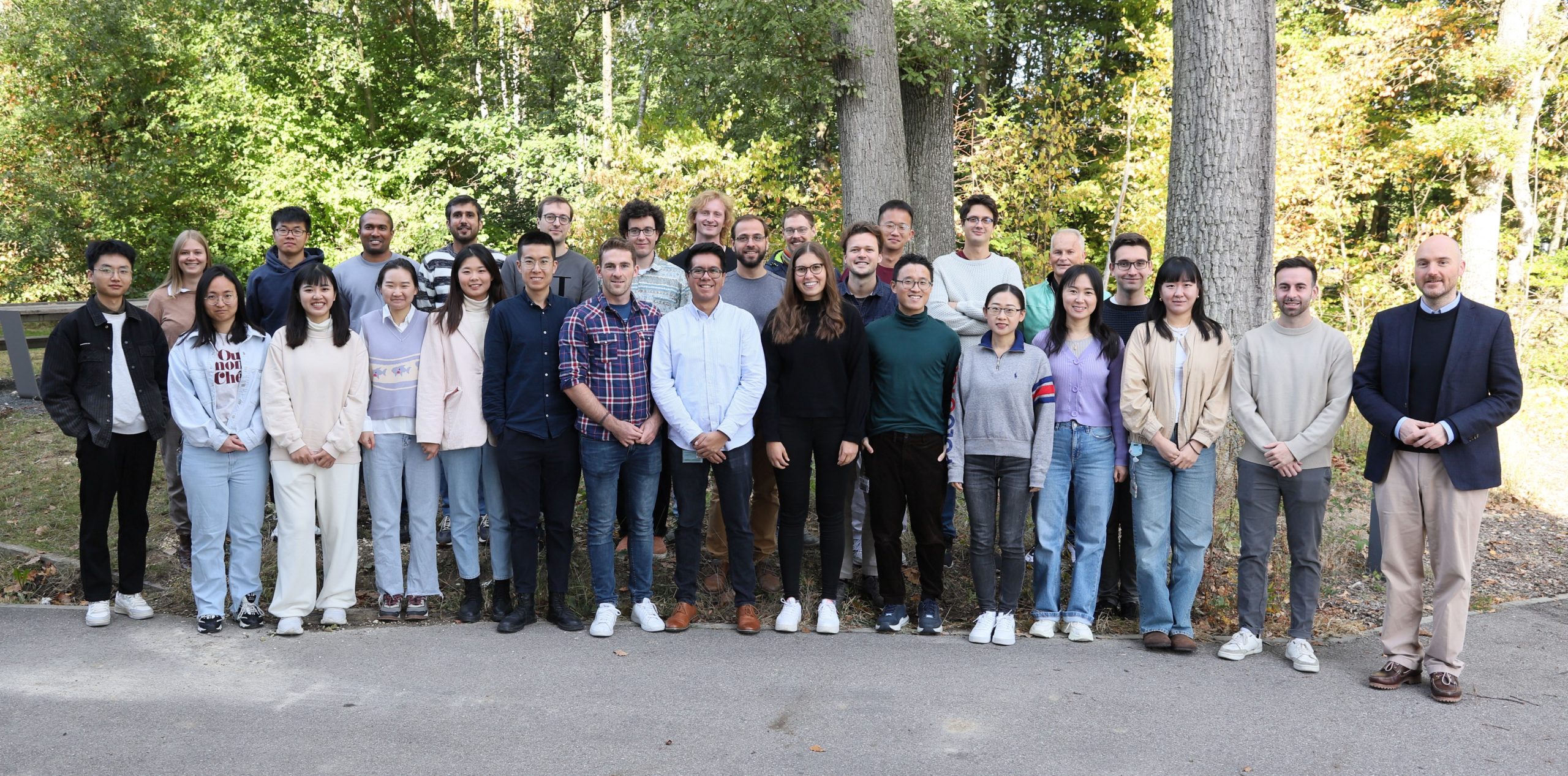HIU-Newsletter
You a scientist yourself? A journalist, a political decision-maker or business representative? In our newsletters we compile the latest battery research news for you. Specially tailored to your personal area of interest.
The research group "Electrochemical Energy Storage Materials" focuses on the development and research of alternative electrode materials and electrolyte systems for lithium-based batteries and related energy storage technologies. The aim is to develop a deeper understanding of the underlying mechanisms and processes that enable and determine the reversible storage of charge carriers and their efficient transport.
The development of new, sustainable and improved active and inactive materials for lithium-based and Li-free battery systems is essential for a successful energy transition. The diversification of the usable energy storage technologies and their optimization for selected applications is seen as a decisive factor. Examples of the work of the group are the research of alternative active materials for the negative electrode based on a combination of alloy and conversion reactions, the targeted introduction of redox-active elements in insertion materials, as well as polymer-based electrolyte systems and organic battery technologies. The goal of better understanding the processes and reactions taking place also always serves the parallel goal of improving and advancing the performance of the materials and electrochemical energy storage as a whole. To this end, the group can fall back on extensive know-how in the synthesis and characterization of energy storage materials and systems and also cooperates with a large number of groups with complementary competencies in Germany, Europe and worldwide.
This research group is partially funded by the Deutsche Forschungsgesellschaft (DFG) through the Cluster of Excellence POLiS.

As science ideally does not know any barriers, we are collaborating with several international research groups, each of them having great expertise in their field, and we will be more than grateful to further extend these collaborative activities in future.
(information will be uploaded shortly)
| Acronym
(Role) |
Research Subject | Funding Organization | Duration (in years) | Funding Period |
| NISE | New ionomers for (quasi)-solid-state high-energy lithium-battery cathodes | KIT-IRGA (UGA) | 3 | 2024-2027 |
| MONaBE | Organic Na-ion batteries | BMBF | 1 | 2024 |
| NESBA | Na-ion battery cathodes | DAAD/BMBF (collaboration with Serbia) | 2 | 2024-2025 |
| SACCESS-2 (PI) | Polymers based on advanced squaric acid amides as new battery electrode materials | DFG | 3 | 2024-2027 |
| ENTISE (PI) | Sodium-ion batteries for stationary applications | BMBF | 3 | 2024-2027 |
| POLiS (PI) | Post Lithium Storage Cluster of Excellence | DFG | 3 | 2023-2025 |
| HighSafe-III (PI & Coordinator) | “Anode-free” Li batteries and ionic liquid-based electrolytes | BMBF-MOST | 3 | 2023-2026 |
| VORAN (PI) | Sodium-ion batteries with a new cell design for stationary storage devices | BMWK | 3 | 2024-2027 |
| RIDERS (PI) | Training in cutting-edge battery technologies | European Commission (MSCA) | 4 | 2024-2027 |
| PRONTO (PI) | Novel cell design for sodium-ion batteries | MWAT – BaWü | 2 | 2022-2024 |
| SiGNE (PI) | High-energy lithium-ion batteries | European Commission | 4 | 2022-2026 |
| LISI-2 (PI) | Lithium/solid electrolyte interface | BMBF-DOE | 3 | 2022-2025 |
| LILLINT-2 (Co-PI) | Thermodynamic and kinetic stability of the lithium-liquid electrolyte interface | BMBF-DOE | 3 | 2022-2025 |
| RACER (PI) | Highly Redox-active Atomic Centers in Electrode Materials for Rechargeable Batteries | ERC Starting Grant – European Commission | 5 | 2022-2027 |
| MATISSE (PI) | Structural batteries for aircraft applications | European Commission | 3 | 2022-2025 |
| FB2-Hybrid (PI) | Competence cluster on all-solid-state batteries – Hybrid systems | BMBF | 3 | 2021-2024 |
| FB2-Polymer (Co-PI) | Competence cluster on all-solid-state batteries – Polymers | BMBF | 3 | 2021-2024 |
| HyPerium (PI) | Hybrid solid-state electrolytes for sodium(‑ion) batteries | BMBF | 3 | 2021-2024 |
| ALANO (Co-PI) | Alternative concepts for the negative electrode in solid-state batteries | BMBF | 3 | 2021-2024 |
| REFA (Co-PI) | Three-electrode cells for solid electrolytes | BMWi | 3 | 2021-2024 |
| H2O-LiMO (PI) | Water sensitivity of lithium battery cathodes | DFG | 2 | 2021-2023 |
| HighSafe-II (Co-PI & Co‑Coordinator) | “Anode-free” Li batteries and ionic liquid-based electrolytes | BMBF-MOST | 3 | 2020-2023 |
| SACCESS (PI) | Polymers based on squaric acid amides and cyclopropenium cations as new battery electrode materials | DFG | 3 | 2020-2023 |
| M2V2LIB (PI) | Modelling the microstructural volume variations and the resulting mechanical properties in lithium-ion battery electrodes | YIN (KIT) | <1 | 2020 |
| ExcellBattUlm (Co-PI) | Sustainable and safe high-performance energy materials | BMBF | 3 | 2019-2022 |
| MOLIBE (Coordinator) | Metal- and liquid-free organic lithium-ion batteries | BMBF-ANR | 4 | 2019-2023 |
| SIPED-BAT (PI) | Single-ion polymer electrolytes for sustainable and safe high-energy density batteries | IDEX (UGA) | 3 | 2019-2022 |
| LISI (PI) | Lithium/solid electrolyte interface | BMBF-DOE | 3 | 2019-2022 |
| LILLINT (Co-PI) | Thermodynamic and kinetic stability of the lithium-liquid electrolyte interface | BMBF-DOE | 3 | 2019-2022 |
| FestBatt (Co-PI) | Competence cluster on all-solid-state batteries – Polymers | BMBF | 3 | 2018-2021 |
| OFELIA (PI) | Conductivity cell for solid electrolytes incl. online thickness determination | DBU | 1 | 2018-2019 |
| NEW E2 (PI) | Alternative anodes for Li-ion batteries | Vector Foundation | 4 | 2017-2020 |
| ABILE (Co-PI) | Air batteries with ionic liquid electrolytes | BMW AG | 3 | 2013-2016 |
As science ideally does not know any barriers, we are collaborating with several international research groups, each of them having great expertise in their field, and we will be more than grateful to further extend these collaborative activities in future.
(information will be uploaded shortly)
| Acronym
(Role) |
Research Subject | Funding Organization | Duration (in years) | Funding Period |
| NISE | New ionomers for (quasi)-solid-state high-energy lithium-battery cathodes | KIT-IRGA (UGA) | 3 | 2024-2027 |
| MONaBE | Organic Na-ion batteries | BMBF | 1 | 2024 |
| NESBA | Na-ion battery cathodes | DAAD/BMBF (collaboration with Serbia) | 2 | 2024-2025 |
| SACCESS-2 (PI) | Polymers based on advanced squaric acid amides as new battery electrode materials | DFG | 3 | 2024-2027 |
| ENTISE (PI) | Sodium-ion batteries for stationary applications | BMBF | 3 | 2024-2027 |
| POLiS (PI) | Post Lithium Storage Cluster of Excellence | DFG | 3 | 2023-2025 |
| HighSafe-III (PI & Coordinator) | “Anode-free” Li batteries and ionic liquid-based electrolytes | BMBF-MOST | 3 | 2023-2026 |
| VORAN (PI) | Sodium-ion batteries with a new cell design for stationary storage devices | BMWK | 3 | 2024-2027 |
| RIDERS (PI) | Training in cutting-edge battery technologies | European Commission (MSCA) | 4 | 2024-2027 |
| PRONTO (PI) | Novel cell design for sodium-ion batteries | MWAT – BaWü | 2 | 2022-2024 |
| SiGNE (PI) | High-energy lithium-ion batteries | European Commission | 4 | 2022-2026 |
| LISI-2 (PI) | Lithium/solid electrolyte interface | BMBF-DOE | 3 | 2022-2025 |
| LILLINT-2 (Co-PI) | Thermodynamic and kinetic stability of the lithium-liquid electrolyte interface | BMBF-DOE | 3 | 2022-2025 |
| RACER (PI) | Highly Redox-active Atomic Centers in Electrode Materials for Rechargeable Batteries | ERC Starting Grant – European Commission | 5 | 2022-2027 |
| MATISSE (PI) | Structural batteries for aircraft applications | European Commission | 3 | 2022-2025 |
| FB2-Hybrid (PI) | Competence cluster on all-solid-state batteries – Hybrid systems | BMBF | 3 | 2021-2024 |
| FB2-Polymer (Co-PI) | Competence cluster on all-solid-state batteries – Polymers | BMBF | 3 | 2021-2024 |
| HyPerium (PI) | Hybrid solid-state electrolytes for sodium(‑ion) batteries | BMBF | 3 | 2021-2024 |
| ALANO (Co-PI) | Alternative concepts for the negative electrode in solid-state batteries | BMBF | 3 | 2021-2024 |
| REFA (Co-PI) | Three-electrode cells for solid electrolytes | BMWi | 3 | 2021-2024 |
| H2O-LiMO (PI) | Water sensitivity of lithium battery cathodes | DFG | 2 | 2021-2023 |
| HighSafe-II (Co-PI & Co‑Coordinator) | “Anode-free” Li batteries and ionic liquid-based electrolytes | BMBF-MOST | 3 | 2020-2023 |
| SACCESS (PI) | Polymers based on squaric acid amides and cyclopropenium cations as new battery electrode materials | DFG | 3 | 2020-2023 |
| M2V2LIB (PI) | Modelling the microstructural volume variations and the resulting mechanical properties in lithium-ion battery electrodes | YIN (KIT) | <1 | 2020 |
| ExcellBattUlm (Co-PI) | Sustainable and safe high-performance energy materials | BMBF | 3 | 2019-2022 |
| MOLIBE (Coordinator) | Metal- and liquid-free organic lithium-ion batteries | BMBF-ANR | 4 | 2019-2023 |
| SIPED-BAT (PI) | Single-ion polymer electrolytes for sustainable and safe high-energy density batteries | IDEX (UGA) | 3 | 2019-2022 |
| LISI (PI) | Lithium/solid electrolyte interface | BMBF-DOE | 3 | 2019-2022 |
| LILLINT (Co-PI) | Thermodynamic and kinetic stability of the lithium-liquid electrolyte interface | BMBF-DOE | 3 | 2019-2022 |
| FestBatt (Co-PI) | Competence cluster on all-solid-state batteries – Polymers | BMBF | 3 | 2018-2021 |
| OFELIA (PI) | Conductivity cell for solid electrolytes incl. online thickness determination | DBU | 1 | 2018-2019 |
| NEW E2 (PI) | Alternative anodes for Li-ion batteries | Vector Foundation | 4 | 2017-2020 |
| ABILE (Co-PI) | Air batteries with ionic liquid electrolytes | BMW AG | 3 | 2013-2016 |
 Prof. Dr. Dominic Bresser Electrochemical Energy Storage Materials Tel: +49 (0731) 50 34101 Mail: dominic.bresser(at)kit.edu
Prof. Dr. Dominic Bresser Electrochemical Energy Storage Materials Tel: +49 (0731) 50 34101 Mail: dominic.bresser(at)kit.edu ORCID: 0000-0001-6429-6048
Scopus Author ID: 54986286700
Scopus Author ID: 57220337887
ResearchGate: Link
Susanne Krauße
Office Prof. Dr. Dominic Bresser
Tel: +49 (0731) 50 34102
Mail: susanne.krausse@kit.edu
You a scientist yourself? A journalist, a political decision-maker or business representative? In our newsletters we compile the latest battery research news for you. Specially tailored to your personal area of interest.